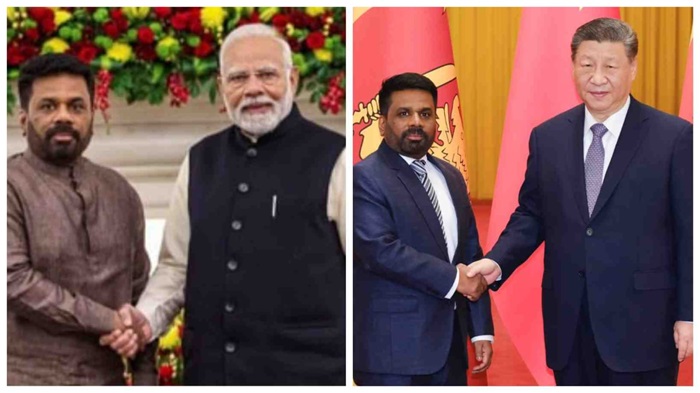
By Dr Sanjana Hattotuwa (Senior disinformation researcher)
Comparing the lengthy, and detailed official statements from India, and China after President Anura Kumara Dissanayake’s (AKD) visits in December 2024, and January 2025 respectively provide insights into Sri Lanka’s recalibration of bilateral relations with two consequential foreign powers.
Commonalities, and shared foci
In both statements, Sri Lanka demonstrates careful diplomatic balancing, with AKD emphasising strong bilateral ties. Both statements reveal Sri Lanka’s commitment to maintaining strategic relationships whilst preserving its sovereignty. They also share common themes around economic cooperation, cultural ties, and development assistance. Structurally,
- Both contain extensive discussions on economic cooperation
- Both address security, and regional stability
- Both conclude with forward-looking commitments, and mutual invitations
Divergences
Economic frameworks: The Indian statement focuses heavily on specific development projects, and granular implementation details, including digital infrastructure, ferry services, and energy cooperation. In contrast, the Chinese statement emphasises Belt and Road Initiative (BRI) cooperation and broader economic frameworks, with particular attention to the Colombo Port City, and Hambantota Port developments.
Security: India’s statement contains explicit security assurances, with Sri Lanka promising that its territory won’t be used “in any manner inimical to the security of India.” The Chinese statement, while addressing security cooperation, focuses more on mutual support for each other’s “core interests,” particularly emphasising Sri Lanka’s support for the One-China principle and positions on Taiwan, Xizang, and Xinjiang.
National debt: The Indian statement provides specific financial figures, mentioning $4 billion in assistance and $20.66 million in debt relief. The Chinese statement takes a more general approach, acknowledging support in debt restructuring without specifying amounts, though it mentions renewing a currency swap agreement.
Tech, and digital or critical national infrastructure (DNI/CNI): India’s statement emphasises digital public infrastructure (DPI), including specific projects like Sri Lanka Unique Digital Identity (SLUDI), and UPI implementation. China’s statement focuses more on traditional infrastructure through the BRI framework, though it does mention digital classrooms and technological cooperation.
Regional framework: India positions its relationship within its “Neighbourhood First” policy and “SAGAR” vision, emphasising maritime security cooperation. China frames the relationship within its broader Belt and Road Initiative and President Xi’s own, and various global initiatives (Development, Security, and Civilization Initiatives).
Maritime issues: While both statements address maritime cooperation, India’s version emphasises practical maritime security measures, including specific mentions of drug trafficking interdiction and maritime surveillance capabilities. China’s approach to maritime issues focuses more on environmental protection, and the concept of a “maritime community with a shared future.”
Cultural engagement: India emphasises practical cultural connectivity through ferry services, and air links, while China’s cultural focus is more ideological, emphasising Buddhist connections, and participation in the Asian Initiative for Cultural Heritage Conservation.
Analysis of language, stress, and foci
Frederic Grare is a senior research fellow at the National Security College of the Australian National University. In October 2024, he published an article in ASPI on AKD’s balancing act between India, and China. The statements after the official visits to both countries show how the considerations, challenges, and tensions noted in Grare’s article are playing out, and how diplomatic language is used to manage what he identified as a situation “dangerously close to a zero-sum game” while attempting to create space for Sri Lanka’s strategic autonomy.
Debt diplomacy: Grare’s article provides critical historical context about Sri Lanka’s economic entanglements with both countries, but especially China. When examining the diplomatic readouts of the bilateral meetings through this lens, one can appreciate underlying power dynamics:
- China’s US$11.2 billion infrastructure investment (2006-2022) explains the prominent positioning of BRI projects in the Chinese statement.
- India’s US$4 billion crisis assistance package (explicitly stressed, and mentioned in the Indian statement) represents strategic economic counterbalancing.
- The Hambantota Port’s 99-year lease to China contextualises both statements’ careful language around maritime cooperation.
Strategic Communication: Both statements exhibit sophisticated attempts at narrative management.
India’s Statement:
- The granular project details, and specific financial commitments appear designed to demonstrate tangible, robust, cross-sectoral, and strategic engagement.
- The explicit security assurances align with what Grare identifies as Indian concerns about Chinese naval presence.
- The emphasis on maritime surveillance, and anti-narcotics cooperation reflects India’s strategy of leveraging its geographic proximity.
China’s Statement:
- The focus on “high-quality Belt and Road cooperation” represents what Grare identifies as China’s need to address debt-trap concerns.
- The extensive sovereignty language around Taiwan, Xizang, and Xinjiang suggests China’s attempt to secure diplomatic support despite AKD’s non-alignment goals, which may be tested under the four Trumpian years ahead.
- The careful framing of Hambantota Port activities indicates awareness of regional sensitivities, and India’s security concerns.
Strategic implications: Grare’s analysis of AKD’s structural constraints helps explain several elements in both statements.
- The Indian statement’s emphasis on DPI, and digitalisation can be read as an attempt to create new structural dependencies across the Palk Strait.
- China’s focus on existing investments reflects its established structural advantages (especially around telecoms infrastructure, aside from other large-scale brick, and mortar infrastructure)
- Both statements’ careful language around maritime activities reflects awareness of what Grare identifies as key irritants in regional relations, and an appreciation that Sri Lanka/AKD has to juggle the sensitivities of both countries.
What does the future hold?
Viewed through Grare’s critical framework, the respective statements suggest:
- AKD’s administration is attempting to operationalise non-alignment through careful diplomatic choreography, and a ‘strategic pragmatism’ as a pathway towards a better defined non-aligment in a multi-polar world.
- Both India and China are adapting their approaches to accommodate Sri Lanka’s balancing act, and the complete reset in relations under AKD, while protecting their core interests.
- The statements reflect an evolving regional architecture where traditional power politics intersects with new forms of economic, and technological influence.
Related reading
- Beyond the Great Firewall: China’s strategic Facebook presence in Sri Lanka, https://sanjanah.wordpress.com/2024/12/13/beyond-the-great-firewall-chinas-strategic-facebook-presence-in-sri-lanka/
- The Global Engagement Centre’s research on China mapped on to Facebook’s manipulation in Sri Lanka, https://sanjanah.wordpress.com/2024/12/27/the-global-engagement-centres-research-on-china-mapped-on-to-facebooks-manipulation-in-sri-lanka/
- Patterns and Trends in Chinese Propaganda on Facebook in Sri Lanka, https://csep.org/reports/patterns-and-trends-in-chinese-propaganda-on-facebook-in-sri-lanka/
